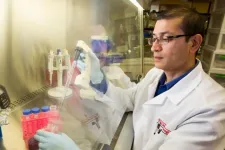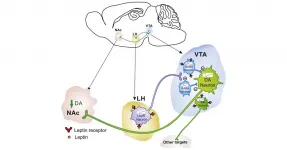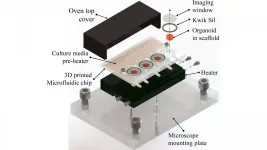(Press-News.org) Researchers at the University of Konstanz and Max Planck Institute for Animal Behavior in Germany have found that birds are able to change their culture to become more efficient. Populations of great tits were able to switch from one behavior to a better alternative when their group members were slowly replaced with new birds. Published today as open access in the journal Current Biology, this research reveals immigration as a powerful driver of cultural change in animal groups that could help them to adapt to rapidly changing environments.
In animals, "culture" is considered to be any behavior that is learned from others, shared by members of the group, and persistent over generations. Cultural traditions are known to exist in many animal groups, including primates, dolphins and whales, rodents, and birds.
Great tits provide a classic example of animal culture. In the 1920s, birds in a town in Great Britain were observed to open the foil tops of milk bottles to steal cream. This behavior spread over 20 years, until birds throughout the country were doing the same.
In 2015 scientists experimentally confirmed that great tits were able to maintain cultural traditions. A new way of feeding--what scientists refer to as an innovation--could be taught to a single bird, and that solution would be learned by other birds and gradually spread throughout populations.
But for great tits, and other animals with cultural traditions, it was still not known if groups can change. Once a tradition has taken root, are animals condemned to repeating the same behaviors or can they pivot to more efficient ones?
Now, the new study has demonstrated that more efficient behaviors can outcompete an established inefficient behavior. It pinpoints a fundamental process--population turnover--as crucial for the ability of animals to change their traditions. The study, which involved teaching wild-caught birds to solve puzzles and fine-scale tracking of their behavior, provides quantitative support for the evolution of culture.
"Experimental evidence of cultural change in animals is pretty rare, so we were surprised and excited by the outcome," says first author Michael Chimento, a doctoral student in the Research Group of Cognitive and Cultural Ecology at the Max Planck Institute of Animal Behavior.
The research team led by senior author Lucy Aplin, who is a Max Planck Research Group Leader and also a principal investigator at the Custer of Excellence 'Centre for the Advanced Study of Collective Behavior' at the University of Konstanz, studied populations of great tits caught from forests around Konstanz. Because wild great tits form changeable social groups during winter, when conditions are harshest, the scientists thought that immigration could play a part in cultural evolution.
"These fluid groups could influence how their culture changes, as new group members might see solutions to problems with clearer eyes, because of their lack of experience," says Chimento.
The researchers used captive populations of wild-caught great tits to ask how fluid social groups might change a socially learned feeding tradition. They created 18 groups of birds, each with an automated puzzle-box that gave a reward. When a bird solved the puzzle, the type of solution, time of solution, and identity were recorded using RFID, infrared, and computer vision technology. Each group had a tutor that was trained on a relatively inefficient puzzle solution, which then spread through the group. Then, half of the groups were kept static, and in the other half, group members were gradually replaced with new birds from wild over the course of 4 weeks.
Despite both types of groups innovating a more efficient solution, fluid groups were much more likely to adopt it as their preferred behavior. The original residents, who were experienced with the puzzle, were generally the ones who innovated the efficient solution, but didn't adopt it as their preferred behavior. The inexperienced immigrants, on the other hand, picked up on this innovation and did adopt it, amplifying the available social information. Birds in fluid groups were able to solve the puzzle-box faster than in static groups, despite having less overall experience.
"Great tits seem to do well in and among human-made habitats, compared to other species," says Chimento. "Our study shows how their fluid social dynamics might be part of their secret to success and contribute to their flexibility.
INFORMATION:
Facts:
-Study shows rare experimental evidence that animals are able to change their culture to become more efficient.
-Using populations of great tits caught in forests around the Konstanz region, the study highlights the crucial role of immigrant birds in enabling populations to adopt more efficient cultures.
-Populations that replaced birds with naïve individuals were able to change from an inefficient culture to a more efficient culture, while populations that had static membership could not.
-Original publication: Population turnover facilitates cultural selection for efficiency in birds. Michael Chimento, Gustavo Alarcón-Nieto and Lucy Aplin. Current Biology (2021) https://doi.org/10.1016/j.cub.2021.03.057
- Michael Chimento and Gustavo Alarcón-Nieto are researchers in the lab of Lucy Aplin who leads the Research Group of Cognitive and Cultural Ecology at the Max Planck Institute of Animal Behavior. Aplin is also a Principal Investigator at the Custer of Excellence 'Centre for the Advanced Study of Collective Behavior' at the University of Konstanz
- Funding was provided by the DFG Centre of Excellence 2117 ''Centre for the Advanced Study of Collective Behaviour'' under Germany's Excellence Strategy-- EXC2117--422037984.
Ann Arbor, April 6, 2021 - New data from the Centers for Disease Control and Prevention (CDC) show that one in four adults with HIV in the United States has experienced intimate partner violence (IPV), which disproportionately affects women and LGBT populations. Further, people with HIV who experienced IPV in the past 12 months were more likely to engage in behaviors associated with elevated HIV transmission risk, were less likely to be engaged in routine HIV care and more likely to seek emergency care services and have poor HIV clinical outcomes. The findings are reported in the American Journal of Preventive Medicine, published by Elsevier.
Lead Investigator Ansley B. Lemons-Lyn, MPH, and colleagues from the CDC's National Center for HIV/AIDS, Viral Hepatitis, ...
At a cost of $38 billion a year, an estimated 5.3 million people are living with a permanent disability related to traumatic brain injury in the United States today, according to the Centers for Disease Control and Prevention. The physical, mental and financial toll of a TBI can be enormous, but new research from the University of Georgia provides promise.
In a new study, researchers at UGA's Regenerative Biosciences Center have demonstrated the long-term benefits of a hydrogel, which they call "brain glue," for the treatment of traumatic brain injury. The new study provides evidence that not only does the gel protect against loss of brain tissue after ...
Bethesda, MD (April 6, 2021) -- Obesity is a global pandemic, affecting about 40% of adults in the United States. There is an enormous unmet need for an effective weight-loss solution. After a detailed review of available literature, the American Gastroenterological Association (AGA) has released new clinical guidelines recommending the use of intragastric balloons (IGB) for patients with obesity who have not been able to lose weight with traditional weight-loss strategies. This treatment is most successful with accompanying therapy, such as lifestyle modifications and pharmacological agents, ...
Researchers have uncovered pathways involved in the body's response to glucocorticoid treatments and identified a novel biomarker that could be used to monitor how these drugs work in patients, according to a clinical study published today in eLife.
A more reliable indicator of an individual's response to glucocorticoid drugs could be used to develop a clinically applicable test that could help tailor treatments and potentially minimise side-effects.
Glucocorticoids, such as cortisol, are a type of hormone with key roles in the body's response to stress. Glucocorticoid ...
Researchers from Skoltech and their collaborators have designed, synthesized and evaluated new compounds that can serve as catholytes and anolytes for organic redox flow batteries, bringing this promising technology closer to large-scale implementation. The two papers were published in the END ...
A new U.S. Geological Survey study provides an updated, statewide estimate of high levels of naturally occurring arsenic and uranium in private well water across Connecticut. This research builds on a USGS report published in 2017, with the new study including additional groundwater samples and focusing on previously underrepresented areas.
The research, undertaken in cooperation with the Connecticut Department of Public Health, projects that approximately 3.9% of private wells across Connecticut contain water with arsenic at concentrations higher than the U.S. Environmental Protection Agency's maximum contaminant level for ...
Sea urchins receive a lot of attention in California. Red urchins support a thriving fishery, while their purple cousins are often blamed for mowing down kelp forests to create urchin barrens. Yet for all the notice we pay them, we know surprisingly little about the microbiomes that support these spiny species.
Researchers at UC Santa Barbara led by geneticist Paige Miller sought to uncover the diversity within the guts of these important kelp forest inhabitants. Their results reveal significant differences between the microbiota of the two species, as well as between individuals living ...
Philadelphia, April 6, 2021 - Since the discovery of leptin in the 1990s, researchers have wondered, how does leptin, a hormone made by body fat, suppress appetite? Despite tremendous gains in the intervening three decades, many questions still remain. Now, a new study in mice describes novel neurocircuitry between midbrain structures that control feeding behaviors that are under modulatory control by leptin. The study appears in Biological Psychiatry, published by Elsevier.
John Krystal, MD, Editor of Biological Psychiatry, said of the findings, "Omrani and colleagues shed light on how, in non-obese animals, leptin puts the brakes on overeating."
Leptin acts as a critical link between the body and the brain, providing information about metabolic ...
In addition to smoothing out wrinkles, researchers have found that the drug Botox can reveal the inner workings of the brain. A new study used it to show that feedback from individual nerve cells controls the release of dopamine, a chemical messenger involved in motivation, memory, and movement.
Such "self-regulation," the researchers say, stands in contrast to the widely held view that the release of dopamine -- known as the "feel good" hormone -- by any cell relied on messages from nearby cells to recognize that it is releasing too much of the hormone.
Led by researchers at NYU Grossman School of Medicine, ...
WASHINGTON, April 6, 2021 -- Scientists from MIT and the Indian Institute of Technology Madras have grown small amounts of self-organizing brain tissue, known as organoids, in a tiny 3D-printed system that allows observation while they grow and develop. The work is reported in Biomicrofluidics, by AIP Publishing.
Current technology for real-time observation of growing organoids involves the use of commercial culture dishes with many wells in a glass-bottomed plate placed under a microscope. The plates are costly and only compatible with specific microscopes. They do not allow for the flow or replenishment of a nutrient medium to the growing tissue.
Recent advances have used a technique known as microfluidics, where a nutrient ...



